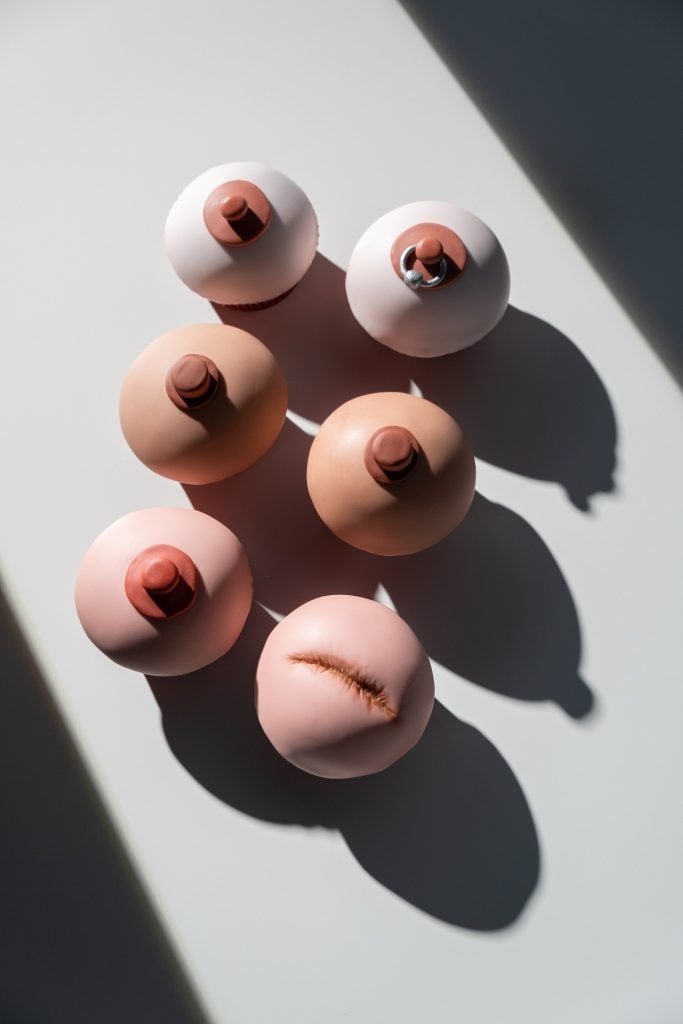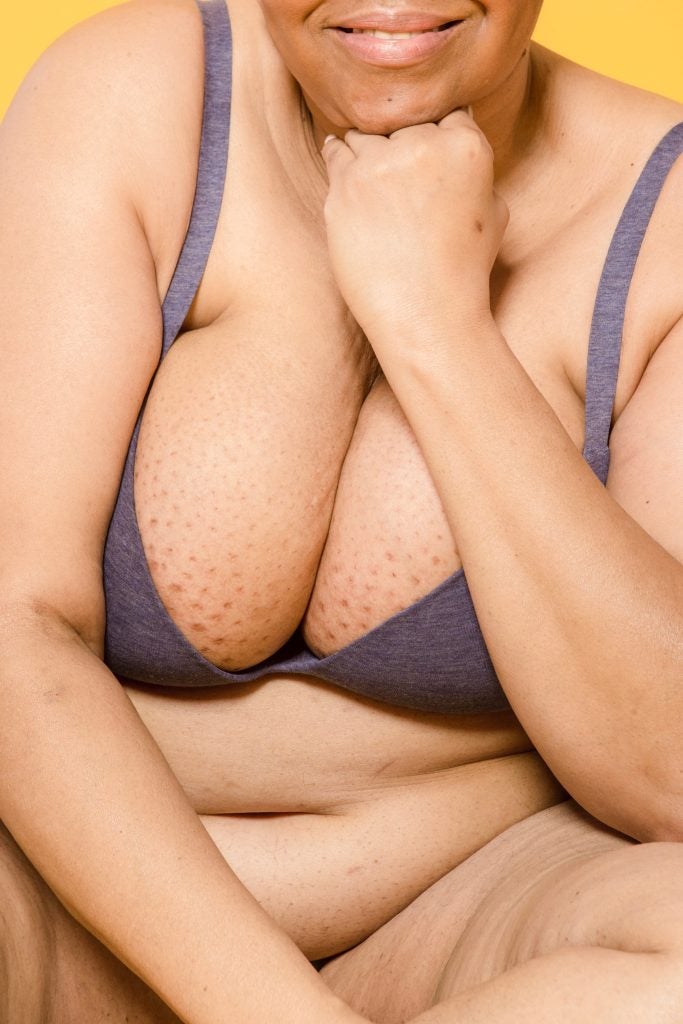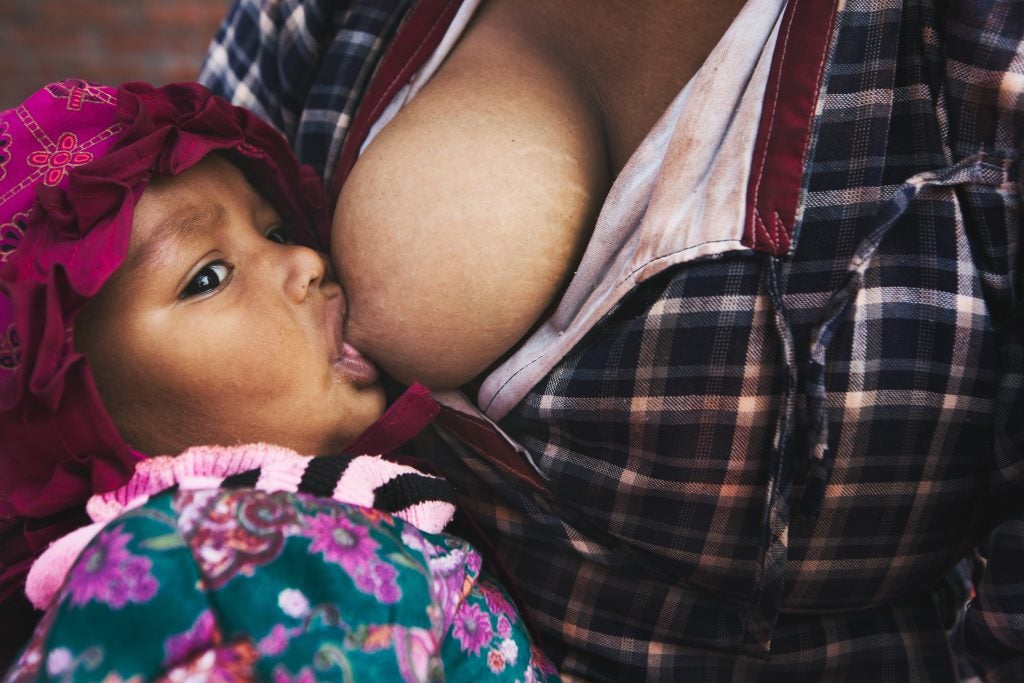
The breast is a tissue that covers both male and female chest muscles. They are secondary sex characteristics and develop differently in males and females. When talking about breasts people generally refer to those of the female. This is because they are an important part of breastfeeding and sexual pleasure. Breasts vary in size, shape, and color from person to person.
Table of Contents
Breast Anatomy
The breasts are among the secondary sex characteristics that distinguish females from males. On an adult woman, the breasts are tear-shaped structures made up of glandular, fatty, and fibrous tissues. The breasts are supported by and attached to the major chest muscle, the pectoralis major, by fibrous strands. A layer of fatty tissues that extend throughout the entire breast surrounds the breast glands. These tissues are what give the breasts their soft consistency. The mammary glands within the breast are what allow the female to secrete milk after pregnancy.1
The amount of glandular tissue present in the breast varies minimally from female to female, despite differences in breast size. These tissues house the lobules (the milk producing glands at the ends of the lobes) and ducts (milk passages). When a female is lactating, the bulbs on the ends of these lobules produce milk. Once this milk is produced, it is transported through the ducts to the nipple.2
The system of milk glands and ducts slightly resembles bundles of grapes, with the ducts being the stems and the glands being the fruits. The milk ducts and glands are separated into several clusters (called lobules). The average female breast consists of 15 to 20 of these bundles. A woman can typically feel these little nodes or lumps right before menstruation.4
The areolas include the darker circular epithelial region (outermost layer of skin) of the external breast. The nipple is located at the center of the areola on each breast. Montgomery glands are small glands that may appear as tiny, raised bumps on the surface surrounding each areola. These sebaceous (oil-producing) glands release protective oil that helps lubricate the nipples during nursing. The nipples also contain openings that act as outlets for the ducts. They are also sensitive to touch and become erect when small muscles at the base of the nipple contract in response to sexual arousal.1 Some may find massaging the nipples to be erotic and pleasurable.
Breast Development

Human breast tissue begins to develop prenatally, during the fifth week of fetal growth. The initial stage of breast development starts with the mammary ridges that extend from the armpits all the way to the groin. The mammary ridges consist of epithelial tissue and appear as 15 to 20 buds. Once the fetus reaches the seventh week of development, the growth regresses to the chest area until two primary breast buds on the upper half of the chest are formed. By the twelfth week of fetal growth the primary buds develop into secondary buds and eventually become lobules. Both newborn females and males are born with identical breasts. Soon after birth the nipples begin to protrude from the areolas and may discharge a milk-like fluid for males and females.1
Polythelia, as shown in the picture above, is also called asaccessory nipple or supernumerary nipple condition. It is described as having an additional nipple to the two that normally develop. This abnormality affects only 2% of females and 1% of males. The appearance of the tertiary nipple can range from looking like a birthmark or mole and are often only recognized due to their location on the body. If polythelia causes distress due to insecure physical appearance, the tertiary nipple can be surgically removed. The third nipple, however, does not cause physical harm or have any specific function. It also does not develop into a full breast. It can simply be seen as another skin individuality. 7
It is not until puberty that the breasts begin to change. Puberty usually begins for young females around the age of 10 or 11, but may begin as early as age 6. In males puberty usually begins around the age of 12, but may begin as early as 9.3 Once puberty is underway, the male breasts respond to high levels of testosterone and low levels of estrogen which stops development.2 The female breasts respond to the estrogen and progesterone produced in the body. These hormonal changes fuel the ducts’ growth, along with the fatty and fibrous breast growth of tissues. The breast ducts develop until menstruation begins (usually two to three years following the beginning of breast development).1
Menstruation prepares the breasts for potential pregnancy. During menstruation, the breast tissue tends to swell due to fluxes in the body’s hormone levels. The milk ducts and glands enlarge to allow the breasts to retain water. These changes may cause the breasts to be tender, swollen, lumpy, or painful during menstruation.4
As a female ages, her breast shape and appearance undergo many changes. The breast skin stretches and expands as the breasts swell, creating a round appearance. There is a tendency for younger females to have denser breasts than older females.2
Breast Variation
It is crucial for females to become familiar with the normal anatomy and physiology of their breasts. This allows them to recognize early signs of abnormalities. However, females should also be aware that variation in breasts is common. A female’s breasts are rarely balanced or completely symmetrical. Usually, one breast is slightly smaller, higher, or shaped differently than the other. Nipples are also subject to much variation among females. They can be flat, round, or cylindrical in shape. They also vary in color from darker to lighter shades of pink, brown, or purple. Some women have very erect nipples, while some may have inverted nipples. Inverted nipples should not cause any concern, unless this characteristic is a change from prior conditions.5
No two breasts are exactly alike. It is senseless to compare one person’s reproductive anatomy to another’s. Although they are all different, no breast is better than the rest! There are many reasons to love your breasts!
Breast Changes During Pregnancy

During pregnancy, the breasts change in a variety of ways. Just a few weeks after conception the breasts typically become tender, and the nipples can feel especially sore. The size of the breasts also increases rapidly. Some women gain a few cup sizes during the first eight weeks of pregnancy. The areola darkens and the Montgomery glands surrounding the areola become more prominent. The nipples grow and become more erect as they prepare for milk production and lactation.
After birth, the hormone levels that were previously responsible for breast changes begin to decrease. During the first three to five days after childbirth, the breast produces a liquid called colostrum, which contains antibodies to help protect the infant from any infections. After a few days, the infant’s immune system has begun to develop, ending the need for colostrum. The breasts then begin to produce breast milk. A female’s body will continue to produce breast milk until she stops breastfeeding. However, it usually takes several months for milk production to stop completely. Once breastfeeding is complete, the breasts usually shrink down to their previous size if the female returns to her prior weight.6
Breast Changes During Menopause
When a female reaches menopause, her body typically stops producing some key hormones necessary for maintaining breast composition. This drop in hormone levels usually results in hot flashes, night sweats, mood changes, vaginal dryness, and difficulty sleeping. During this time, the breasts also undergo some changes. For some females, the breasts become more tender and lumpy and may form cysts (pockets of fluid).4 The glandular tissue in the breast shrinks and is replaced with fatty tissue. The breasts tend to increase in size and sag as the fibrous tissues lose their strength.5
Male Breasts
When discussing breasts, males are often disregarded due to the fact that their breasts do not serve as significant of a function as female breasts. However, males can also have breasts of different shapes, sizes, and color due to different hormone levels and different genes.
Gynecomastia
Gynecomastia is the enlargement of breasts due to higher amounts of estrogen or lower amounts of testosterone produced in a male’s body. More than half of all male infants are born with gynecomastia due to the estrogen they are exposed to through their mothers. This enlargement of infant breast tends to go away within 2 to 3 weeks after birth. During male puberty, gynecomastia is relatively common due to the change in hormone levels. Breast enlargement from puberty tends to go away within 6 months to 2 years. Gynecomastia can arise again in males between the ages of 50 and 80. Some rare cases of gynecomastia never settle and hormone treatment or surgery can be used to minimize breast size.8
Breast Health
Due to the frequency and severity of breast cancer and other related conditions, breasts are a major focus of health concern. Breast self-exams are recommended in order to recognize natural and abnormal breast changes. Speaking with a doctor about breast changes is beneficial in keeping track of development and possible prevention or treatment of breast conditions.
Breast Cancer
Cancer is defined as the uncontrolled growth of abnormal cells in the body. Breast cancer is a form of cancer that commonly appears in the inner lining of the milk ducts or the lobular areas within the mammary gland. During its later stages, breast cancer may also spread to the lymph nodes (bean shaped masses that filter the blood) near the neck and armpit. Currently, about 1 in 8 U.S. females, and 1 in 1000 U.S. males will develop breast cancer over the course of their lifetime. Despite this high diagnosis rate, the survival rate of those who are diagnosed with stage 0 cancer is up to 93% for non-invasive duct related growths. More information about breast cancer can be found here.9
Breast Self-Exams
Breast self-exams (BSEs) are a simple and relatively effective way to screen for changes in breast tissue at home without a doctor or nurse. A BSE should be conducted with a doctor’s approval, one week after your normal menstrual period begins and the typical swelling and/or tenderness in the breasts has subsided. To conduct the exam, begin by removing all clothes above the waist. Visually inspect the breasts in front of a mirror with arms at your sides, above your head, and on your waist for any noticeable changes in appearance or coloration. For most women, breasts are not identical, so do not be alarmed if they are not the same size or shape. Next, raise one arm and inspect the upper areas of the breast and the armpit for any lumps, rashing, or dimpling. With one arm still raised, lightly squeeze the nipple to check for variation in color, density, or any kind of discharge. Finally, lay down on your back. Using the pads of the three middle fingers of your left hand, move in small coin-sized circles over the right breast. Repeat this procedure using the other hand for the left breast. Implement lighter levels of pressure to check tissue close to the surface of the skin, and use stronger levels of pressure to check tissue close to the ribs or breastbone. Continue to examine the entire breast using a lengthwise strip or spiral pattern that extends from the collarbone to the bra line and from the armpit to the breastbone. By the end of a BSE, females and males should know how their breasts look and feel normally. Any unexpected changes should be promptly reported to a doctor for further examination.9
Breasts and Sex
Both males and females may find that their breasts and nipples are sensitive. Breasts contain many nerves that can be responsible for sexual arousal. Stimulation of the breasts can be seen as erotic or sexually pleasing. Touching or stroking breasts and nipples, whether it is manually or orally, can be incorporated into foreplay or any other sexual activity for heightened pleasure. Some males and females may not enjoy stimulation of their breasts and nipples due to either heightened or decreased sensitivity. Communicating with a partner about their preferences can help couples engage in mutually pleasurable sexual interactions.10
Concluding Remarks
Breasts have a high degree of variation in appearance, development, health, and sensitivity. As breasts develop it is advised to keep track of and recognize the changes to one’s body. Please remember that breast maturity and formation occur in many different ways for males and females. Accepting one’s breasts is a good way to elicit confidence and self-value.
References
- Lemaine, Valerie, and Patricia S. Simmons. “The Adolescent Female: Breast and Reproductive Embryology and Anatomy.” The Adolescent Female (2012): n. pag. John Wiley & Sons, Inc. Web. 9 Oct. 2016. Last Updated: 2012
- “Breast Anatomy.” Komen. N.p., Web. 09 Oct. 2016. Last Updated: 23 Mar. 2016
- “For Parents: What to Expect When Your Child Goes Through Puberty.” Family Doctor. N.p., Web. 09 Oct. 2016. Last Updated: Nov. 2010
- “Understanding Breast Changes: A Health Guide for Women.” National Cancer Institute. N.p., Web. 09 Oct. 2016. Last Updated: 23 Apr. 2015.
- “Normal Breast Development and Changes.” Johns Hopkins Medicine. N.p., n.d. Web. 09 Oct. 2016.
- “Breast Changes During Pregnancy-Topic Overview.” WebMD. WebMD, n.d. Web. 09 Oct. 2016.
- “Polythelia.” Breast Surgery. N.p., n.d. Web. 29 Oct. 2016.
- Mayo Clinic Staff. “Gynecomastia.” Causes. N.p., n.d. Web. 29 Oct. 2016.
- Breastcancer.org. N.p., Web. 29 Oct. 2016. Last Updated: 18 Feb. 2016
- “Breast Pleasure.” Health, Fitness, Beauty & Diet. N.p., Web. 29 Oct. 2016. Last Updated: 24 Aug. 2015
Last Updated: 03 November 2016.
